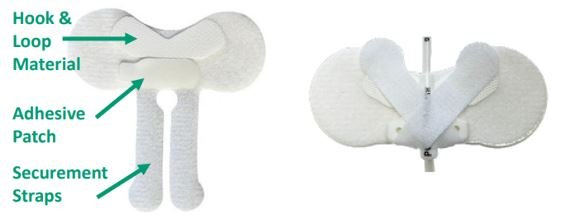ALERT: What do I need to know about new securement devices for central venous access devices?
Connected Care Quick Hits are up to date and evidence based recommendations for the care of children with medical complexity & technology dependence, from hospital to home.
ALERT: What do I need to know about new securement devices for central venous access devices?
SITUATION:
This QuickHit was informed by a product change of securement devices for central venous access devices (CVAD) at SickKids. Due to backorders and limited supply availability, some children will be using Clik-FIX® in replacement of StatLock™ for CVAD securement devices.
BACKGROUND:
Many children with medical complexity rely on CVADs in home and community care for long-term intravenous therapy including medication administration, parenteral nutrition, dialysis, hydration, and blood sampling. Types of CVADs include central venous lines (CVL) and peripherally inserted central catheters (PICC)
Securement devices are an important method of stabilizing and preventing accidental dislodgement of CVADs. Some children have changed the type of CVAD securement device products they are using from StatLock™ to Clik-FIX® .
ASSESSMENT:
StatLock™ and Clik-FIX® securement devices are both considered appropriate for use in the care of children with CVADs in transition from hospital to home. A previous QuickHit provides an overview of how StatLock™ securement devices are used.
The new Clik-FIX® securement devices are now available in some settings, in two sizes. The small securement devices can be used for CVADs that are 3 Fr or smaller in diameter and the large securement devices can be used for CVADs that are 4 Fr or larger..
The Clik-FIX® securement devices are designed with a universal chevron securement method. The securement devices are made with a soft low-profile material which helps ensure the dressing is occlusive and prevents tenting of the dressing.
RECOMMENDATION:
Connected Care recommends the following best practices when caring for a child with a Clik-FIX® CVAD securement device in home and community:
Assess the child’s CVAD site, securement device and dressing daily to ensure that it is clean, dry and intact. Change CVAD dressings and securement devices every 7 days or as needed if loose or soiled.
The Clik-FIX® CVAD securement device does not have posts that can be inserted into the wings of the CVAD. Instead, ensure the ‘securement straps’ are pointing towards the CVAD insertion site once secured, as demonstrated in the image below.
The ‘securement straps’ on the Clik-FIX® CVAD securement device can be easily attached and removed from the ‘hook and loop material’. For this reason, the securement device must be covered by the dressing. It can be covered by the main dressing or additional dressing tapes depending on the external length of the CVAD, as outlined in the images below.
For CVADs with a long external length: place the main dressing first and then the securement device with additional dressing tapes on top (image on left)
For CVADs with a short external length: place the securement device first then the main dressing and additional dressing tapes (image on right)
Review the following resources on how to perform CVAD dressing change procedures with the Clik-FIX® CVAD securement device.
Explore options for alternative securement devices if a Clik-FIX® CVAD securement device is not available at home. Review this Quick Hit that outlines best practices and alternative methods for securement of CVADs.
Ensure that a fully assembled CVAD emergency kit remains with the child at all times in case of accidental dislodgement. Review the following video on how to manage dislodgements and other CVAD emergency procedures.
Initiate a Connected Care Live consultation for 'real-time' support on how to place, use or remove CVAD securement devices.

















